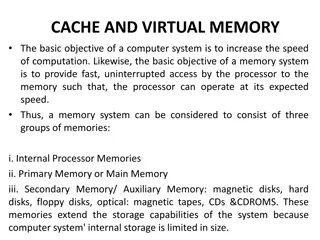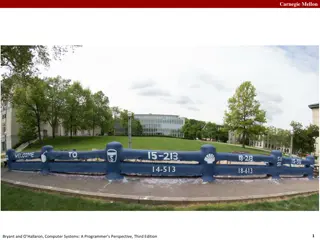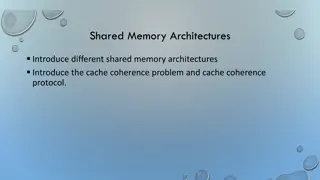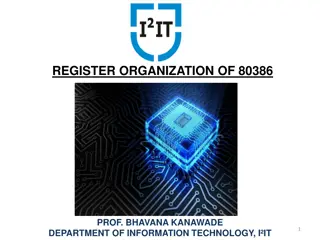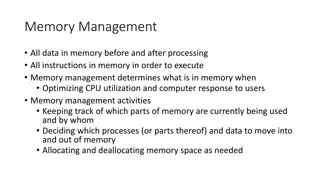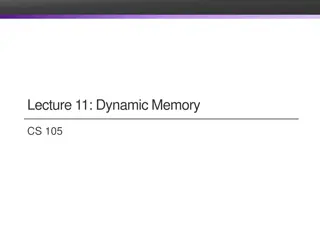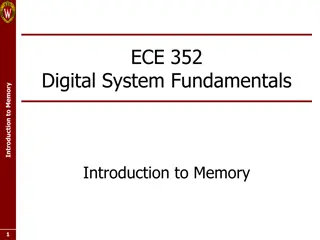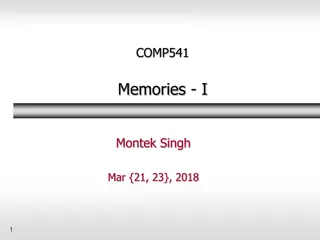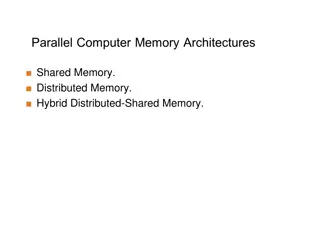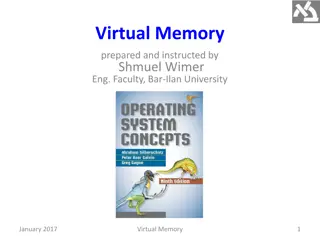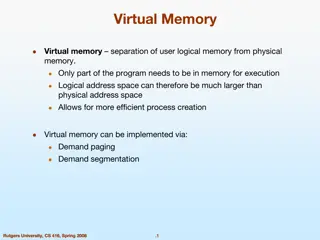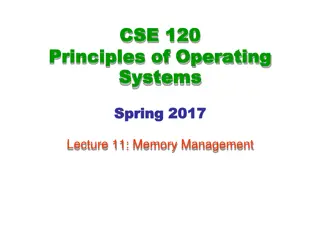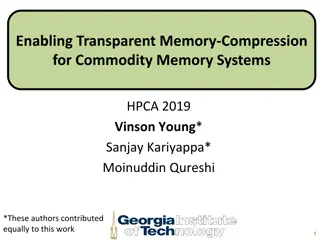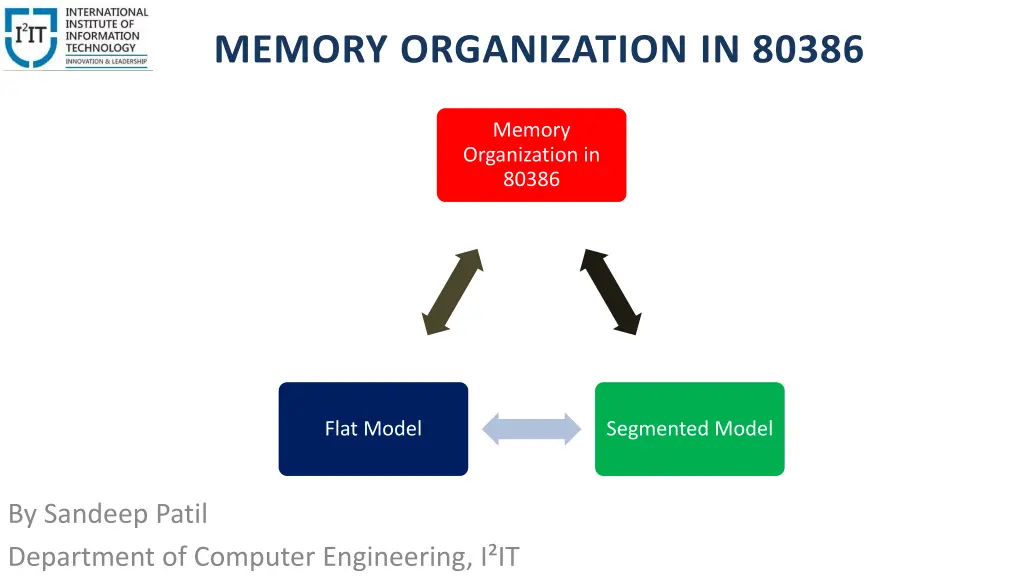
Understanding Memory Organization in 80386
Explore the memory organization in the 80386 microprocessor, including the flat and segmented models. Learn how programmers can develop programs independently of physical memory space. System software designers provide different models based on task requirements. Dive into the details of flat model organization and its applications.
Download Presentation

Please find below an Image/Link to download the presentation.
The content on the website is provided AS IS for your information and personal use only. It may not be sold, licensed, or shared on other websites without obtaining consent from the author. If you encounter any issues during the download, it is possible that the publisher has removed the file from their server.
You are allowed to download the files provided on this website for personal or commercial use, subject to the condition that they are used lawfully. All files are the property of their respective owners.
The content on the website is provided AS IS for your information and personal use only. It may not be sold, licensed, or shared on other websites without obtaining consent from the author.
E N D
Presentation Transcript
MEMORY ORGANIZATION IN 80386 Memory Organization in 80386 Flat Model Segmented Model By Sandeep Patil Department of Computer Engineering, I IT
Outline Introduction to Memory Organization Model of memory organisation Flat Model Segmented Model Conclusion International Institute of Information Technology, I IT, P-14 Rajiv Gandhi Infotech Park, Phase I MIDC, Hinjawadi, Pune - 411 057 Tel +91 20 22933441 | Website - www.isquareit.edu.in | Email - info@isquareit.edu.in
Introduction to Memory Organization In 80386 Microprocessor , the physical memory is organized as a sequence bytes. A unique address range is in between zero to a maximum of 2^32-1 as shown in the following figure . 2^32-1 0 1 2 . . . . . This can totally map 2^32 means 4 gigabytes physical address space. International Institute of Information Technology, I IT, P-14 Rajiv Gandhi Infotech Park, Phase I MIDC, Hinjawadi, Pune - 411 057 Tel +91 20 22933441 | Website - www.isquareit.edu.in | Email - info@isquareit.edu.in
80386 Programs The 80386 programmer require no knowledge of this physical address space. He/she can develop the 80386 programs without knowing how much physical memory is available, exactly where the 80386 program is located in the over all address space. need can be written without knowledge of how much So the 80386 programs are independent of physical address space. International Institute of Information Technology, I IT, P-14 Rajiv Gandhi Infotech Park, Phase I MIDC, Hinjawadi, Pune - 411 057 Tel +91 20 22933441 | Website - www.isquareit.edu.in | Email - info@isquareit.edu.in
Model of memory organisation System Software designers provides the model of memory organisation for the applications programmers. Depending on the task, different models of memory organisation can be selected. There are two end types of the model of memory organization. Flat Model Segmented Model International Institute of Information Technology, I IT, P-14 Rajiv Gandhi Infotech Park, Phase I MIDC, Hinjawadi, Pune - 411 057 Tel +91 20 22933441 | Website - www.isquareit.edu.in | Email - info@isquareit.edu.in
Flat Model Organised as single array of 2^32 bytes ( 4 gigabytes) Much smaller An ordinal pointer value is from 0 to 232-1 to cover flat address space Systems software like linkers, locators, binders, loaders relocation of separately-compiled modules International Institute of Information Technology, I IT, P-14 Rajiv Gandhi Infotech Park, Phase I MIDC, Hinjawadi, Pune - 411 057 Tel +91 20 22933441 | Website - www.isquareit.edu.in | Email - info@isquareit.edu.in
Segmented Model The logical address space of 246 bytes (64 terabytes) is mapped onto the physical address space (up to 4 gigabytes). A segment is a unit of contiguous address space. Segment sizes may range from one byte up to a maximum of 232 bytes (4 gigabytes). International Institute of Information Technology, I IT, P-14 Rajiv Gandhi Infotech Park, Phase I MIDC, Hinjawadi, Pune - 411 057 Tel +91 20 22933441 | Website - www.isquareit.edu.in | Email - info@isquareit.edu.in
Segmented Model A pointer in this address space has two parts as shown in the following figure. ( Source: INTEL 80386 PROGRAMMER'S REFERENCE MANUAL 1986) International Institute of Information Technology, I IT, P-14 Rajiv Gandhi Infotech Park, Phase I MIDC, Hinjawadi, Pune - 411 057 Tel +91 20 22933441 | Website - www.isquareit.edu.in | Email - info@isquareit.edu.in
Segmented Model 1. A segment selector is a 16-bit field. 2. It is the identifier of the segment. 3. An offset is a 32-bit ordinal number. 4. It maps to the byte in the selected segment. International Institute of Information Technology, I IT, P-14 Rajiv Gandhi Infotech Park, Phase I MIDC, Hinjawadi, Pune - 411 057 Tel +91 20 22933441 | Website - www.isquareit.edu.in | Email - info@isquareit.edu.in
Conclusion Memory protection is provided by both the models. Depending of the task, designer can choose the required model. International Institute of Information Technology, I IT, P-14 Rajiv Gandhi Infotech Park, Phase I MIDC, Hinjawadi, Pune - 411 057 Tel +91 20 22933441 | Website - www.isquareit.edu.in | Email - info@isquareit.edu.in
THANK YOU For further information please contact Prof. Sandeep Patil Department of Computer Engineering Hope Foundation s International Institute of Information Technology, I IT Hinjawadi, Pune 411 057 Phone - +91 20 22933441 www.isquareit.edu.in | sandeepp@isquareit.edu.in




